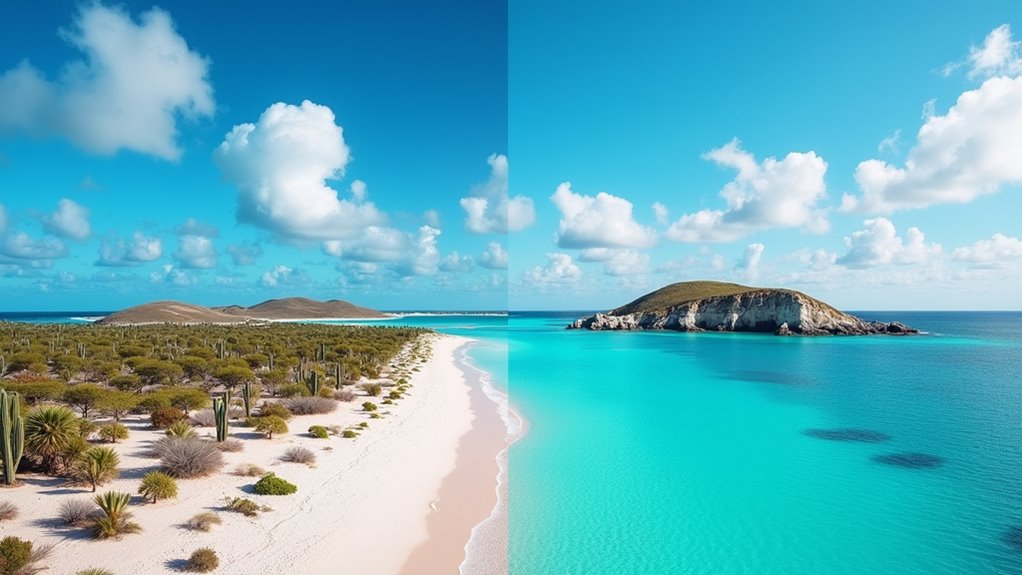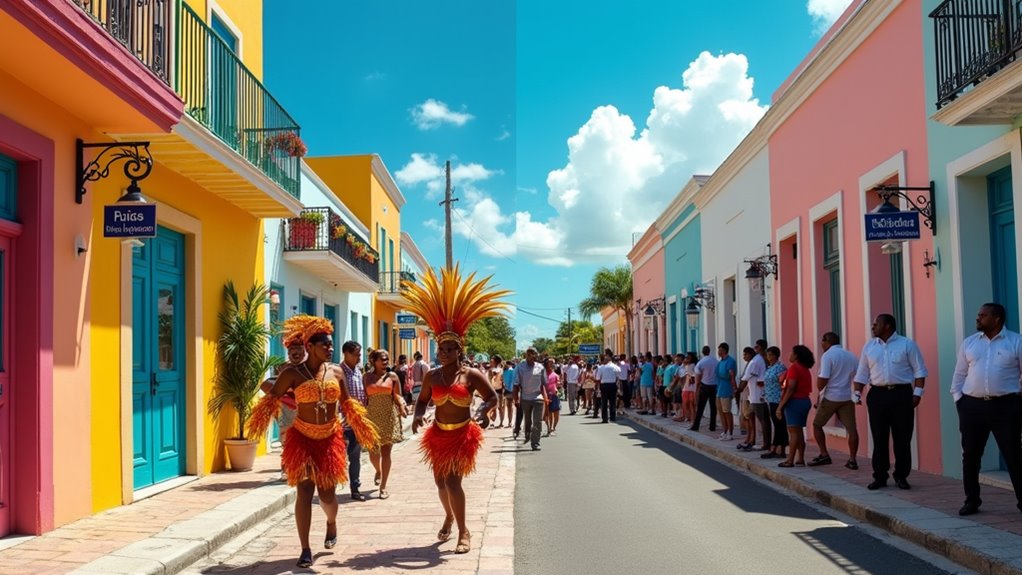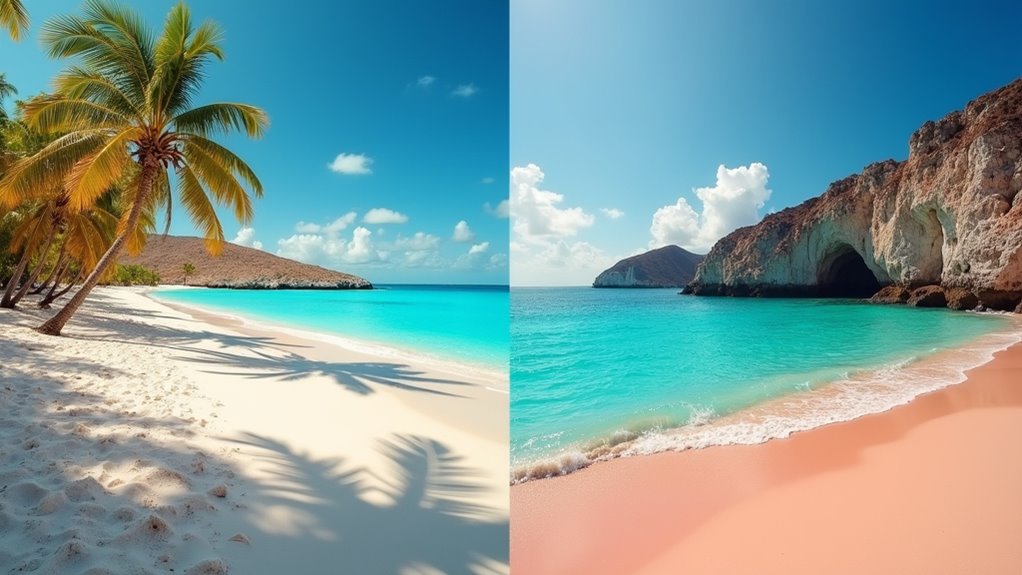Physical Address
304 North Cardinal St.
Dorchester Center, MA 02124
Physical Address
304 North Cardinal St.
Dorchester Center, MA 02124

In this ultimate island face-off, discover whether Aruba's desert charm or Bermuda's British elegance best suits your dream vacation.
Aruba offers a consistently warm, arid climate with desert-like terrain, while Bermuda features a mild, lush environment with higher hurricane risk. You’ll find Aruba more affordable with vibrant nightlife and water sports, compared to Bermuda’s higher costs and British-influenced charm. Aruba provides universal healthcare and multilingual culture, whereas Bermuda has private insurance and a financial-sector economy. Your ideal destination depends on whether you prefer lively entertainment or scenic sophistication. Our complete guide reveals all the vital differences.

The two islands couldn’t be more different in their physical makeup. Aruba offers you 180 square kilometers of mostly flat, arid landscape near Venezuela’s coast. Bermuda provides just 54 square kilometers of hilly, lush terrain isolated in the North Atlantic. This means Aruba is approximately 3.3 times larger than Bermuda.
You’ll find consistently warm weather in Aruba (27-31°C year-round) with minimal rainfall, creating desert-like conditions perfect for dependable sunny vacations. Bermuda’s subtropical climate brings more seasonal variation—mild 16°C winters and 28°C summers—with higher humidity and regular rainfall supporting its greenery. Unlike Hawaii, both islands have relatively few spider species to worry about during your vacation.
If you’re concerned about hurricanes, Aruba sits safely outside the hurricane belt with stable trade winds keeping conditions predictable. Bermuda, however, faces higher hurricane risks, especially from August through October.
When comparing the economic landscapes of these island destinations, you’ll immediately notice stark differences in their financial profiles.
Bermuda boasts a GDP per capita of $99,800, more than double Aruba’s $41,300, reflecting its robust financial services sector.
You’ll find Bermuda markedly more expensive for daily living. Housing, food, utilities, and transportation all come with premium price tags compared to Aruba.
This stems from Bermuda’s remote location and high import costs.
While both islands use currencies pegged to the US dollar, their tax systems differ dramatically.
Bermuda offers a low-tax environment attractive to businesses, while Aruba maintains a more structured taxation system.
Both economies rely heavily on tourism, though Bermuda’s financial sector provides additional economic stability that Aruba lacks.
Residents in Bermuda enjoy 2.4 times more income than their counterparts in Aruba, which significantly impacts purchasing power and quality of life.
Unlike neighboring Caribbean islands like Barbados with its deadly wildlife concerns, both Aruba and Bermuda offer relatively safe natural environments for travelers exploring their economies.

Comparing Aruba and Bermuda’s populations reveals significant demographic contrasts that shape each island’s distinct cultural identity.
With approximately 108,849 residents, Aruba ranks 187th globally and 13th in the Caribbean. It maintains a dense population of about 605 people per square kilometer.
You’ll encounter an aging population with a median age of 40.36 years and a unique gender imbalance—only 0.90 males per female.
The island’s cultural tapestry blends Amerindian, African, European, and Caribbean influences, reflected in its multilingual society where Papiamento, Dutch, Spanish, and English coexist.
Aruba’s demographic composition benefits from positive migration, primarily from neighboring Caribbean islands and South America. Much like how surf culture influences demographic patterns in destinations such as Hawaii and Bali, tourism plays a significant role in Aruba’s population dynamics.
Current statistics show this small island nation has a fertility rate of 1.6 children per woman, well below the replacement level needed for population stability.
This migration contributes to its 0.19%-0.45% annual growth rate despite below-replacement fertility levels of 1.88 births per woman.
Looking beyond demographics, health systems in Aruba and Bermuda reflect their distinct governance approaches and cultural priorities.
In Aruba, you’ll benefit from universal healthcare modeled after the Netherlands, with mandatory insurance providing extensive coverage to all residents. The system emphasizes preventative care with low wait times and subsidies for low-income individuals. As part of the Dutch Caribbean, Aruba maintains high-quality healthcare services comparable to European standards. Similar to safe travel destinations like Canada, Aruba provides visitors with access to reliable emergency medical services.
Bermuda offers no universal coverage, instead relying on employment-based or private insurance. While healthcare quality is high, accessibility depends on your financial situation, with significant out-of-pocket costs for the uninsured.
Health outcomes vary accordingly: Aruba boasts lower rates of preventable hospitalizations and better chronic disease management, while Bermuda shows strengths in technological adoption but struggles with diabetes complications and heart failure rates above OECD averages.

Both Aruba and Bermuda offer distinct vacation experiences that cater to different types of travelers.
In Aruba, you’ll find Eagle Beach’s stunning white sands and the diverse landscapes of Arikok National Park. The island boasts vibrant nightlife with casinos and excellent snorkeling opportunities. For those seeking a festive atmosphere, Aruba is among the top Caribbean destinations for partying and entertainment. Oranjestad, the capital, delivers shopping and historical tours with Dutch, Spanish, and indigenous cultural influences. Travelers can easily explore the island with rental cars available, making it convenient to visit multiple attractions in a single day.
Bermuda counters with the famous pink sands of Horseshoe Bay and Pink Sand Beach. Gibbs Hill Lighthouse provides panoramic views from its cast iron structure. The island reflects strong British influences in its architecture and customs, creating a different cultural atmosphere than Aruba’s diverse heritage.
Your choice depends on preferences: Aruba for lively entertainment and water sports or Bermuda for unique beaches and British charm.
Whether you’re seeking the desert-like charm of Aruba or Bermuda’s lush landscapes, you’ve now got the facts to make a smart choice. Both islands offer unique experiences that won’t necessarily break the bank if you plan strategically. Like two sides of the same coin, each destination shines in its own way—your perfect island getaway depends entirely on your personal priorities and travel style.